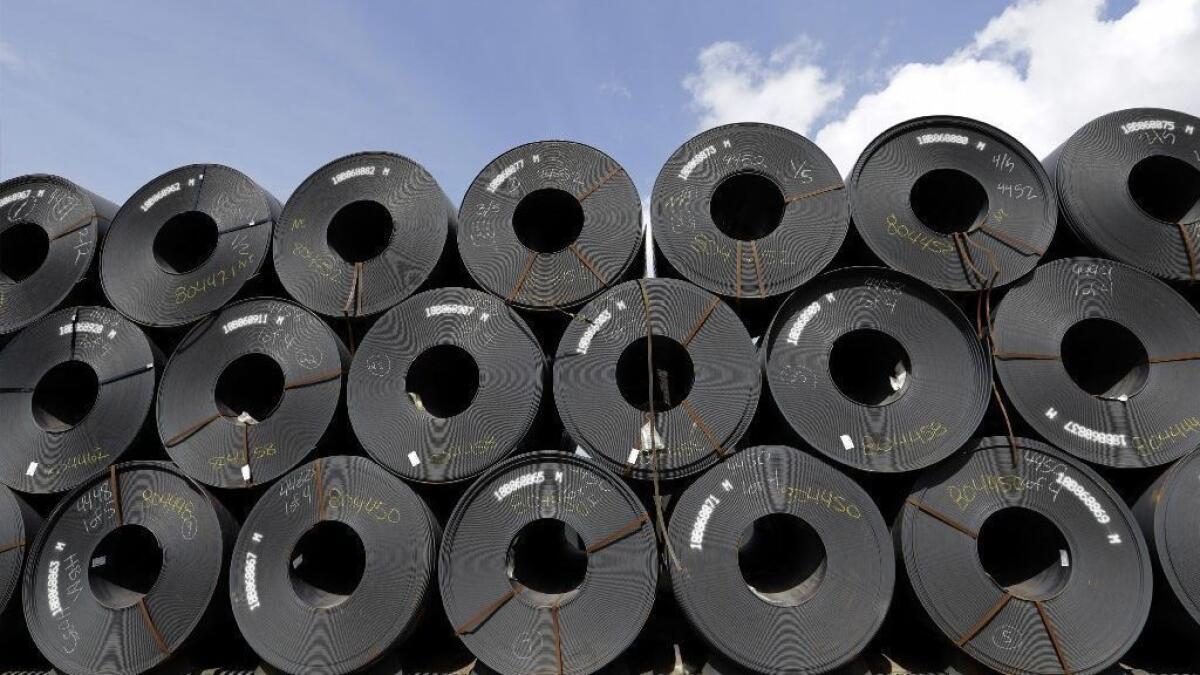Trump agrees to lift steel tariffs on Canada and Mexico, boosting chances for trade accord

- Share via
Reporting from Washington — Eager to score a victory on trade, President Trump agreed Friday to remove a large set of tariffs, rather than impose new ones as he has been prone to do, to boost the chances of getting Congress to approve the renegotiated North American Free Trade Agreement.
Trump agreed to withdraw tariffs of 25% and 10%, respectively, on billions of dollars of steel and aluminum from Canada and Mexico that he had imposed a year ago. In return, Canada and Mexico said they would lift retaliatory duties on many American goods, including politically sensitive farm products.
The agreement clears one major hurdle for Trump in his bid to get the revised NAFTA through Congress. Trump had faced heavy bipartisan criticism in Congress for levying tariffs on neighboring countries, particularly Canada, America’s close ally. The tariffs were imposed under a section of trade law that allows the president to respond to national security threats, a designation that especially angered Canadians.
“I am pleased to announce that we’ve just reached an agreement with Canada and Mexico, and we will be sending our product into those countries without the imposition of tariffs or major tariffs,” Trump said Friday in announcing the agreement. “Hopefully, Congress will pass the USMCA quickly,” he added, using his preferred acronym for the revised NAFTA.
The announcement came just hours after Trump took another conciliatory step, delaying for up to six months his threat to impose sweeping new tariffs on imported autos and auto parts, also on the basis of threats to national security. Had Trump decided to go ahead with those tariffs, it would have sparked a major backlash and likely retaliation from trading partners. After Canada and Mexico, Japan and Germany are the two biggest exporters of autos to the United States.
Taken together, Trump’s two moves, delaying one set of tariffs and lifting another, could help deescalate tensions with allies as the administration intensifies its trade fight with China, with whom the United States has the largest trade imbalance and has long struggled to even the playing field.
After many months of trade talks, the United States and China appear to be at an impasse, with both sides having ratcheted up tariffs and digging in on their positions. Trump’s unilateral approach to trade and his aggressive use of tariffs have caused friction with allies and adversaries alike.
Analysts said they remained uncertain whether Trump, who has repeatedly praised tariffs, was truly now looking to ease tensions with allies and build a coalition to help bring China to heel, as many lawmakers and policy experts have urged him to do. In postponing the auto tariffs, for example, Trump largely repeated his argument that auto imports constitute a threat to U.S. security, a position rejected by many U.S. trading partners.
“The automotive tariff threat will continue to hover over the negotiations with Japan and the EU,” said Wendy Cutler, a top trade negotiator for Presidents George W. Bush and Obama and now with the Asia Society Policy Institute. “It doesn’t mean that the [Trump] administration has a clean slate on trade with them.”
Trump’s removal of steel and aluminum tariffs, however, won widespread applause from businesses and lawmakers.
“The biggest hurdle to ratifying USMCA has been lifted,” said Sen. Chuck Grassley, (R-Iowa). The Senate Finance Committee chairman had said the metal tariffs made USMCA a nonstarter.
But the North American deal remains far from assured of ratification by Congress, which is required before it can go into effect. Congressional Democrats have said they would not support the agreement unless changes were made to provisions on enforcing labor rights and the duration that drug companies can keep exclusivity for their products.
“It is a good thing these tariffs will be lifted, and we should urge our allies to join us in preventing China’s predatory practices,” said Sen. Charles E. Schumer, (D-N.Y.), the Senate Minority leader. But, he added, “There are still many other issues that are outstanding before Democrats would support the USMCA.”
For months, Trump had resisted advice from lawmakers and administration officials to remove the 25% duties on imported metals that he imposed on Canada, Mexico and other countries. Trump wanted to keep protecting domestic steelmakers and help factory workers, who are among his strongest supporters, and he saw the tariffs as leverage for getting better deals from trading partners.
But Canadian officials, and prominent Republican senators, had made clear that the revisions to NAFTA could not win approval of either Congress or the Canadian Parliament unless the tariffs were lifted. Canada is the United States’ largest steel and aluminum trading partner.
Trump spoke Friday with Canadian Prime Minister Justin Trudeau, their third call in about a week, according to a statement from the Canadian government.
“This is pure good news,” Trudeau said, referring to the tariff agreement during a visit Friday to a steel plant in Hamilton, Ontario.
“As we look at moving forward with the new NAFTA, it didn’t make a lot of sense to continue to have tariffs on steel and aluminum between our countries,” he said, adding that the tariffs were “harming workers and consumers on both sides of the border.”
In a joint statement, the U.S. and Canada agreed that the metal tariffs would be lifted by Sunday.
The U.S. imported about $14 billion of steel and aluminum from Canada last year. After the United States imposed the metal tariffs last June, Canada hit back with tariffs of 10% to 25% on about $13 billion of U.S. goods, including steel, whiskey, appliances and motorboats.
The two sides agreed to take steps not to import steel and aluminum sold at below-market prices or produced with unfair subsidies and to prevent shipment of those metals from other countries — a provision aimed at preventing Chinese metals from being shipped through Canada to the U.S.
The two countries also agreed that they could issue tariffs and counter-tariffs on a narrow basis in case of surges of imports.
Although Mexico was also covered by the tariffs, it is a much smaller producer of industrial metals than either the U.S. or Canada. The U.S. imported about $3.5 billion in steel and aluminum from Mexico last year. Mexico had also imposed retaliatory tariffs, mostly on farm and food goods, including apples, pork and cheese.
Mexico’s deputy foreign minister, Jesus Seade, said his country “enthusiastically welcomes” the agreement. “This action will clear the way to progress on ratification of the USMC trade agreement,” he said.
The tariffs have boosted steel production and investments in the United States. Domestic steel factory utilization in early May reached 81.7%, up from 76.4% a year ago, according to the American Iron and Steel Institute.
But the import taxes also have hurt a much wider array of domestic companies that have struggled with higher metal prices and supply problems.
“I think the administration was feeling a lot of pressure to deliver, either to resolve some conflicts and to get out from under retaliation, and of course it would be nice for the president if he could show some results,” said Philip Levy, senior fellow at the Chicago Council on Global Affairs and a White House economist under President George W. Bush.
As a tactic in trade talks, administration officials and supporters say the tariffs have worked, at least in bringing parties to the table and, in Canada and Mexico’s case, in agreeing to revise NAFTA, one of Trump’s key campaign promises. The three countries reached their deal on the newly named U.S.-Mexico-Canada Agreement last fall.
Critics, however, said Canada and Mexico were willing all along to negotiate changes to the NAFTA agreement and that the tariffs were not needed.
Staff Writer Tracy Wilkinson contributed to this report.
More to Read
Get the L.A. Times Politics newsletter
Deeply reported insights into legislation, politics and policy from Sacramento, Washington and beyond. In your inbox twice per week.
You may occasionally receive promotional content from the Los Angeles Times.











